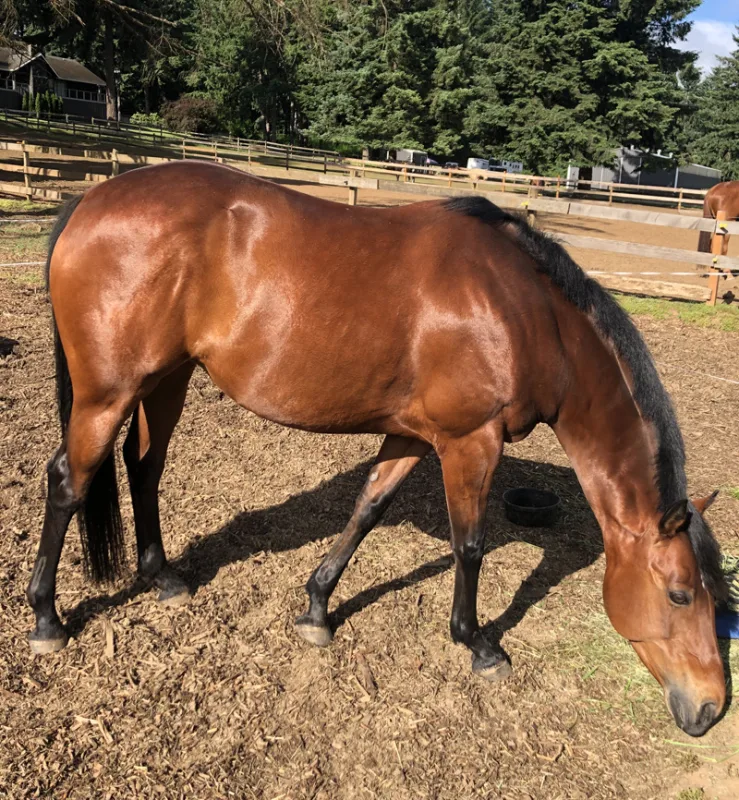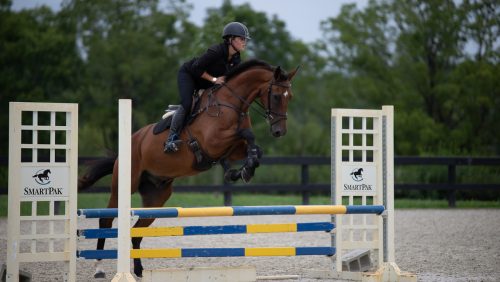Kids, I am here to tell you that just because you grow up, it doesn’t mean you outgrow crying over your pony.
Or in this case small horse.
It was the last day of Cairo’s rehab from her strained check ligament, and we were almost done with her ulcer treatment. Summer was drawing closer, and I was dreaming of jumps and beach rides after a long, kinda crappy winter and stressful rehab. We were at 20 minutes of trot and two 5-minute canter sets, and the Queen of Cairo was getting fit.
But Cairo came up lame, this time on her right hind. She’d felt crabby for the last day or two, and I was concerned about the change in her mood because shortly after we started treating her squamous and glandular ulcers, she’d been pretty cheerful.
And there she was, lame. I hopped off her, checked her feet and put her on the longe.
Lame.
A rock, I told myself; she’s stepped on a rock. No heat, no swelling. I cleaned her up and put her away. The next day, I longed her and thought she looked pretty good. Still, I thought it was better to give her a day or two to rest. My friend Becky and I looked at her the following day, and she looked pretty good to us, so I waited one more day and hopped on.
Cairo was sullen and more behind the leg than she’s ever been. Not lame, per se. But not right. In some ways, it seemed similar to her stone bruise, but I just didn’t have a good feeling. I reluctantly scratched the Yves Sauvignon clinic I had signed up for and made a veterinary appointment instead.
This was not the way I had planned to start our show season and summer.
My veterinarian, Dr. Wes Violet, could see the mild lameness right away and did a work-up. We X-rayed her hock and stifle, and as it turns out, Cairo has excellent joints. Not bad for a 10-year-old mare going prelim.
The only thing we found was a weirdness in the scar tissue over her hock from an old injury, something Dr. Violet believed to probably be a red herring. His next appointment of the day arrived, and seeing that I was freaking out over my little mare, he offered to keep her there for the day and ultrasound her later. As it turned out, his day got crazy, and he amazingly stayed way too late into the evening to ultrasound my horse.
We found some inclusive elements on her high suspensory, something we couldn’t rule out, but nothing that screamed out, “This is why she’s lame.”
We decided to inject the hock and waited. I was still freaking out.
ADVERTISEMENT
I took an in-hand trot video a couple of days later. I was thinking she looked pretty good. “Nope,” said my veterinarian. “Not right, give her more time.”
Five more days and another video. Still nope, he said. I sent the video to my event trainer Meika Decher. She could see it too. (I now want to sit and watch endless YouTube horse videos so I too can learn to spot the most subtle of lamenesses.)
I will interrupt my story here and say I know we all tend to complain about veterinary bills, but every veterinarian I work with goes above and beyond for my animals. They not only have to deal with creatures in pain, but also humans who are not at their best because we are stressed and worried about our animals. And then our veterinarians have to respond to late night emergencies and early morning calls. And still take the time to look at trot videos in their “spare” time.
I think most of us, myself included, need to complain less and bring more presents to the veterinarian. I currently owe several of them the beverage of their choice. It’s not their fault I have a passion in life that means I epitomize the phrase “horse poor.” (I prefer it as “horse poor but heart happy.”)
Dr. Violet sent me up the lameness specialists at Northwest Equine Performance near Portland for a consult. Dr. Rachel Gottlieb, an ultrasound specialist and all-around nice person, is also the veterinarian at several of the shows I go to and has repeatedly had to tell me, “Your horse is fine,” when I’m fretting over something at a show. I was sincerely hoping to get there and be told that whatever it was, it was fine now.
Fantasies like that make a two-hour trailer ride with your lame heart-horse more doable.
Cairo got a thorough going over again, and there it was on the scan: An injury to her proximal suspensory on her right hind.

Cairo had a bit of scar tissue in her hock, but it was the proximal hind suspensory that was likely causing her lameness.
I kind of knew that’s what it was going to be. Looking back, all the signs pointed to it: Cairo’s ulcers and sullenness under saddle. Her refusing fences last summer. Rachel said there was some irritation in Cairo’s left hind too and that this had probably been brewing for a while until something tweaked it. Treating the ulcers and improving the saddle fit helped Cairo feel better, but they didn’t fix the underlying problem in her suspensory ligament.
On the one hand, I’m sad I didn’t catch this earlier. Poor performance is a sign of suspensory problems. On the other hand, Cairo wasn’t lame; she had passed the jog at The Event at Rebecca Farm (Montana), and she did have ulcers, and high suspensories don’t really swell and get hot like other tendon and ligament damage.
But I had this ongoing nagging feeling all through the fall that things weren’t right, a feeling that I attributed to needing to build our trust in jumping. When she was diagnosed with ulcers the second time, I figured that was it. Turns out her suspensories were aggravated.
I’m glad I didn’t push her. I’m glad I didn’t hit her when she was hurting, and I’m glad this happened during our rehab so that the injury was fairly mild, and we were not jumping a fence at a show or clinic where she might have caused a big tear. I’m glad that this is something that, if all goes well, is fixable.
Still, I don’t want this to have happened to Cairo at all.
I cried. I tried to hold it together, but it turned out I needed a hug from Dr. Rachel before we extracted the blood for the platelet-rich plasma. Add that to the list of things they probably don’t teach in veterinary school and don’t charge for but veterinarians probably find themselves doing quite often.
ADVERTISEMENT
Rachel said the PRP was optional, but shockwave was recommended treatment. It’s Cairo, so PRP and shockwave it is! And anything else the veterinarians recommend over the nine months of rehab. I have amazing veterinarians around me from Dr. Violet and Rachel to my friend Dr. Ellie, and I’m so glad to have people who caught this and are giving my sometimes-less-than-cooperative horse everything she needs.
Cairo was her better self for all the treatments, with only one drunk-girl semi-threat of a pathetic slow-motion kick after the shockwave that just made Rachel laugh.
People ask me how Cairo’s doing, and I don’t know. It’s not an injury that heats up or swells. Instead, I tell them, ‘Well she’s fat and bored.’ And that I’m paranoid she’s going to do something silly in her little 20′ by 20′ paddock or handwalking that will negatively impact her recovery, and I can’t see it or feel it.
And yeah, Cairo’s going to be super pissed off when she figures out I have put her on a diet.
And I’m pretty down but trying to find the positive. Cairo is my heart horse and riding her gives me wings. I don’t know about the rest of you, but riding and jumping—this horse in particular—is a huge part of what makes me who I am.
And yes, you can bond while rehabbing, but our wings are clipped for the foreseeable future, and I don’t think either of us is thrilled about it. Several folks have offered me horses to ride, and that’s lovely, and I am enjoying it, even if showing them is not financially an option.
Dr. Rachel tells me the prognosis is good and that we can get back to prelim again. I think maybe I need to record that and put it on repeat play on my phone as Cairo and I handwalk.
My barn friends and even non-horse friends have been crazy supportive, emotionally and every other way. In fact, I’m pretty sure a couple of them have bought used tack off me they may or may not actually need in order to help me treat Cairo in the way she clearly feels she should be accustomed to.
I’m grateful it’s not worse. I’m grateful it’s not career-ending. My mare is resting in her small paddock and stall and is as happy as a sassy, hot mare can be on forced rest. I’m back to getting up early and handwalking before and after work, and we go back in for a recheck in July.
I’m open to suggestions on how to keep a hot, currently weight-challenged mare in rehab happy, quiet and ulcer-free. Right now she’s on Purina Outlast, Equine G.I. Matrix and corn oil and a little bit of alfalfa for her ulcers. Her hay is served in Nibble Nets for her amusement. (The corn oil and alfalfa are veterinarian recommended for her ulcers, in case you’re wondering why I’d be feeding those to her in her slightly zaftig state.)
I’ve said it before, and I will say it again. We’re going to make a comeback. The Queen of Cairo will jump all the things again. But first, handwalking. Lots of it.

















